Mohammad Javad Omidi
Enhancing Energy and Spectral Efficiency in IoT-Cellular Networks via Active SIM-Equipped LEO Satellites
Aug 23, 2025



Abstract:This paper investigates a low Earth orbit (LEO) satellite communication system enhanced by an active stacked intelligent metasurface (ASIM), mounted on the backplate of the satellite solar panels to efficiently utilize limited onboard space and reduce the main satellite power amplifier requirements. The system serves multiple ground users via rate-splitting multiple access (RSMA) and IoT devices through a symbiotic radio network. Multi-layer sequential processing in the ASIM improves effective channel gains and suppresses inter-user interference, outperforming active RIS and beyond-diagonal RIS designs. Three optimization approaches are evaluated: block coordinate descent with successive convex approximation (BCD-SCA), model-assisted multi-agent constraint soft actor-critic (MA-CSAC), and multi-constraint proximal policy optimization (MCPPO). Simulation results show that BCD-SCA converges fast and stably in convex scenarios without learning, MCPPO achieves rapid initial convergence with moderate stability, and MA-CSAC attains the highest long-term spectral and energy efficiency in large-scale networks. Energy-spectral efficiency trade-offs are analyzed for different ASIM elements, satellite antennas, and transmit power. Overall, the study demonstrates that integrating multi-layer ASIM with suitable optimization algorithms offers a scalable, energy-efficient, and high-performance solution for next-generation LEO satellite communications.
MIMO-NOMA Enabled Sectorized Cylindrical Massive Antenna Array for HAPS with Spatially Correlated Channels
Jun 30, 2024



Abstract:The high altitude platform station (HAPS) technology is garnering significant interest as a viable technology for serving as base stations in communication networks. However, HAPS faces the challenge of high spatial correlation among adjacent users' channel gains which is due to the dominant line-of-sight (LoS) path between HAPS and terrestrial users. Furthermore, there is a spatial correlation among antenna elements of HAPS that depends on the propagation environment and the distance between elements of the antenna array. This paper presents an antenna architecture for HAPS and considers the mentioned issues by characterizing the channel gain and the spatial correlation matrix of the HAPS. We propose a cylindrical antenna for HAPS that utilizes vertical uniform linear array (ULA) sectors. Moreover, to address the issue of high spatial correlation among users, the non-orthogonal multiple access (NOMA) clustering method is proposed. An algorithm is also developed to allocate power among users to maximize both spectral efficiency and energy efficiency while meeting quality of service (QoS) and successive interference cancellation (SIC) conditions. Finally, simulation results indicate that the spatial correlation has a significant impact on spectral efficiency and energy efficiency in multiple antenna HAPS systems.
Multi-BD Symbiotic Radio-Aided 6G IoT Network: Energy Consumption Optimization with QoS Constraint Approach
Jan 29, 2024Abstract:The commensal symbiotic radio (CSR) system is proposed as a novel solution for connecting systems through green communication networks. This system enables us to establish secure, ubiquitous, and unlimited connectivity, which is a goal of 6G. The base station uses MIMO antennas to transmit its signal. Passive IoT devices, called symbiotic backscatter devices (SBDs), receive the signal and use it to charge their power supply. When the SBDs have data to transmit, they modulate the information onto the received ambient RF signal and send it to the symbiotic user equipment, which is a typical active device. The main purpose is to enhance energy efficiency in this network by minimizing energy consumption (EC) while ensuring the minimum required throughput for SBDs. To achieve this, we propose a new scheduling scheme called Timing-SR that optimally allocates resources to SBDs. The main optimization problem involves non-convex objective functions and constraints. To solve this, we use mathematical techniques and introduce a new approach called sequential quadratic and conic quadratic representation to relax and discipline the problem, leading to reducing its complexity and convergence time. The simulation results demonstrate that the proposed approach outperforms other outlined schemes in reducing EC.
Sum Throughput Maximization in Multi-BD Symbiotic Radio NOMA Network Assisted by Active-STAR-RIS
Jan 16, 2024Abstract:In this paper, we employ active simultaneously transmitting and reflecting reconfigurable intelligent surface (ASRIS) to aid in establishing and enhancing communication within a commensal symbiotic radio (CSR) network. Unlike traditional RIS, ASRIS not only ensures coverage in an omni directional manner but also amplifies received signals, consequently elevating overall network performance. in the first phase, base station (BS) with active massive MIMO antennas, send ambient signal to SBDs. In the first phase, the BS transmits ambient signals to the symbiotic backscatter devices (SBDs), and after harvesting the energy and modulating their information onto the signal carrier, the SBDs send Backscatter signals back to the BS. In this scheme, we employ the Backscatter Relay system to facilitate the transmission of information from the SBDs to the symbiotic User Equipments (SUEs) with the assistance of the BS. In the second phase, the BS transmits information signals to the SUEs after eliminating interference using the Successive Interference Cancellation (SIC) method. ASRIS is employed to establish communication among SUEs lacking a line of sight (LoS) and to amplify power signals for SUEs with a LoS connection to the BS. It is worth noting that we use NOMA for multiple access in all network. The main goal of this paper is to maximize the sum throughput between all users. To achieve this, we formulate an optimization problem with variables including active beamforming coefficients at the BS and ASRIS, as well as the phase adjustments of ASRIS and scheduling parameters between the first and second phases. To model this optimization problem, we employ three deep reinforcement learning (DRL) methods, namely PPO, TD3, and A3C. Finally, the mentioned methods are simulated and compared with each other.
Low-overhead Joint Channel Estimation and Data Detection in ZP-OTFS System
Apr 04, 2023



Abstract:High pilot overhead and peak-to-average power ratio (PAPR) are challenging issues in channel estimation for orthogonal time frequency space (OTFS) systems. ZP-OTFS is a modified OTFS system where multiple rows along the delay axis are zero. We propose a two-step channel estimation method for the ZP-OTFS system. The proposed method inserts pilot sequences in the zero bins of the ZP-OTFS system, resulting in low overhead and PAPR. Our simulation results demonstrate the effectiveness of the proposed method and show that it outperforms embedded pilot estimation in terms of normalized mean square error (NMSE) at the same bit error rate (BER).
Superimposed Channel Estimation in OTFS Modulation Using Compressive Sensing
Dec 19, 2022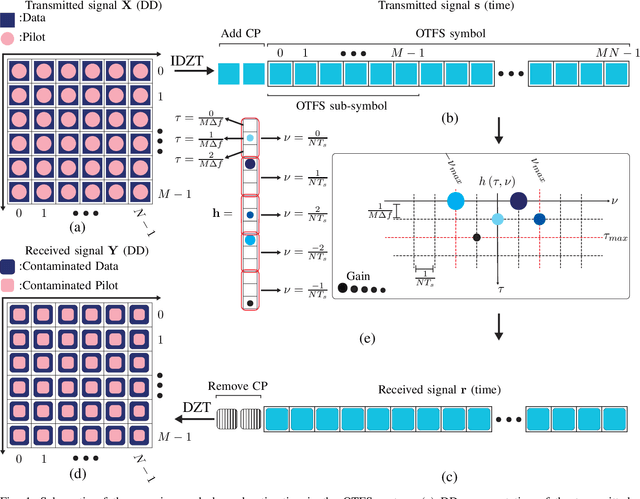
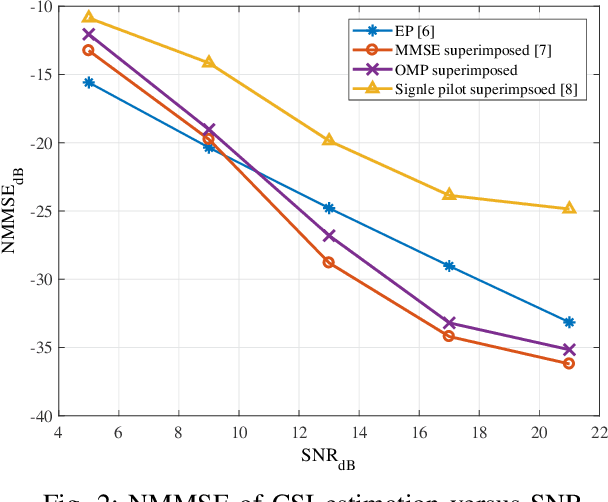
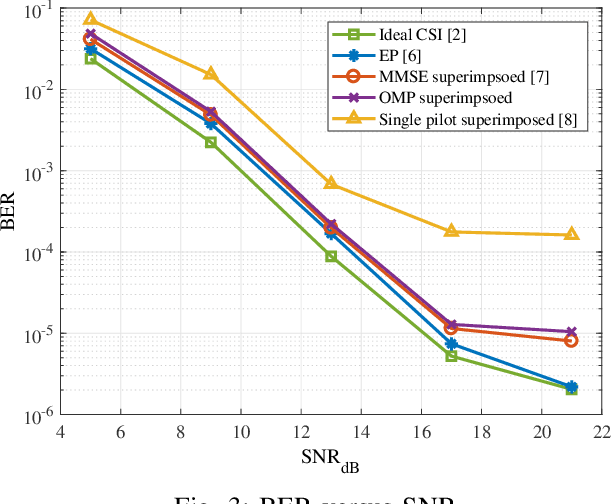
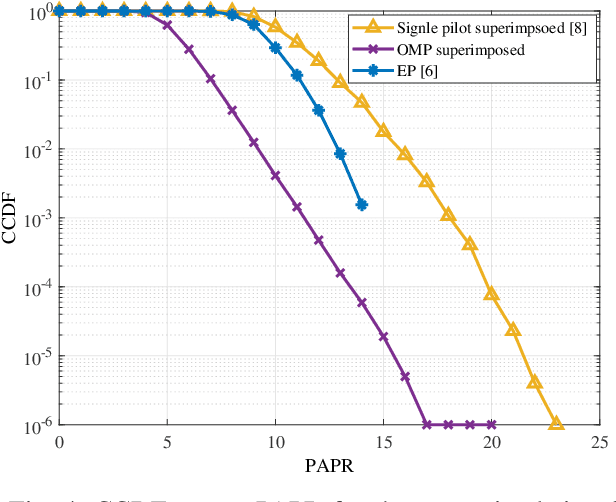
Abstract:Orthogonal time frequency space (OTFS) technique is a two-dimensional modulation method that multiplexes information symbols in the delay-Doppler (DD) domain. OTFS combats high Doppler shift existing in high speed wireless communication. However, conventional channel estimation in OTFS suffers from high pilot overhead because guard symbols occupy a significant part of the DD domain grids. In this paper, a superimposed channel estimation is proposed which can completely estimate channel parameters without considering pilot overhead and performance degradation. As the channel state information (CSI) in the DD domain is sparse, a sparse recovery algorithm orthogonal matching pursuit (OMP) is used. Besides, our proposed method does not suffer from high peak to average power ratio (PAPR). To detect information symbols, a message passing (MP) detector, which exploits the sparsity of DD channel representation, is employed.
Power Allocation for a HAPS-Enabled MIMO-NOMA System with Spatially Correlated Channels
Sep 27, 2022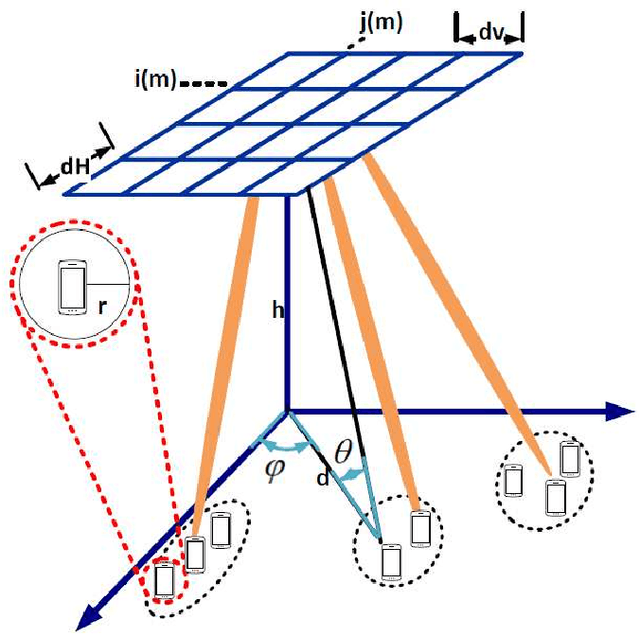
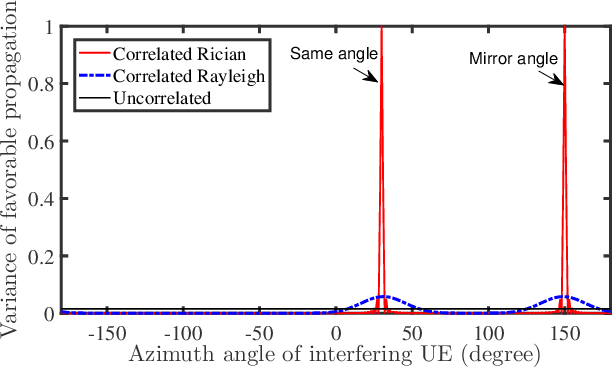
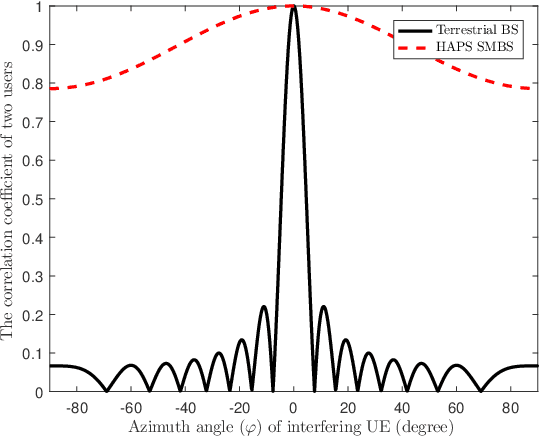
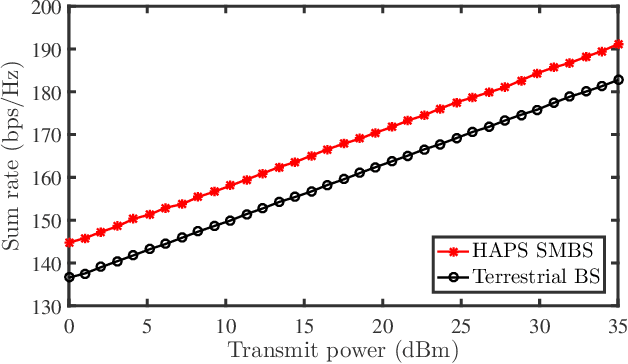
Abstract:High-altitude platform station (HAPS) systems are considered to have great promise in the multi-tier architecture of the sixth generation (6G) and beyond wireless networks. A HAPS system can be used as a super macro base station (SMBS) to communicate with users directly since there is a significant line-of-sight (LoS) link between a HAPS and terrestrial users. One of the problems that HAPS SMBS systems face, however, is the high spatial correlation between the channel gain of adjacent users, which is due to the LoS link between the HAPS and terrestrial users. In this paper, in addition to utilizing the spatial correlation of channel gain between multiple users to improve user services, we consider correlated channel gain for each user. In the proposed method, terrestrial users with a high spatial correlation between their LoS channel gain are grouped into NOMA clusters. Next, an algorithm is proposed to allocate power among terrestrial users to maximize the total rate while satisfying the quality-of-service (QoS) and successive interference cancellation (SIC) conditions. Simulation results show that a HAPS SMBS has superior data rate and energy efficiency in comparison to a terrestrial BS.
 Add to Chrome
Add to Chrome Add to Firefox
Add to Firefox Add to Edge
Add to Edge